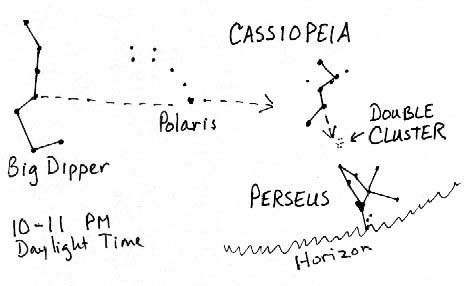 Along with the Big Dipper and Orion, Cassiopeia (KAS-ee-oh-PEE-uh) is one of the best-known star groupings. Like its circumpolar partner, the Big Dipper, it has an easily recognizable shape, and is usually or always visible in northern latitudes. While the Big Dipper is highest during the spring and summer, Cassiopeia rules autumn and winter.
Along with the Big Dipper and Orion, Cassiopeia (KAS-ee-oh-PEE-uh) is one of the best-known star groupings. Like its circumpolar partner, the Big Dipper, it has an easily recognizable shape, and is usually or always visible in northern latitudes. While the Big Dipper is highest during the spring and summer, Cassiopeia rules autumn and winter.
And "rules" is the correct word, for Cassiopeia represents an Ethiopian queen, and the constellation is often identified as her throne. In mythology, she was banished by gods for daring to brag about her own beauty and that of her daughter Andromeda. She is chained to her throne and forced to spend part of the year hanging upside down.
To find Cassiopeia, find the star in the Big Dipper where the handle joins the cup. Trace a line from that star to Polaris, and continue in that direction approximately the same distance again until you see a group of stars shaped like a wide, tilted, W or M.
The W will then point you toward this week's main event, the Perseid meteor shower. Draw a line from the central peak of the W to the lower left star, and it will point toward Perseus. Perseus is still partially below the horizon at sunset, a bit east of due north. As it rises during the evening, it will swing around toward the east.
While meteors should be visible originating from this region throughout August, the peak will be late on Tuesday, August 12. Unfortunately, the one-day-past-full Moon will brighten the sky and wash out many of the fainter meteors. Don't let that deter you. Take a lawn chair or a blanket to your favorite dark spot and orient yourself in the general direction of Cassiopeia and Perseus. Don't bother with binoculars or telescopes - you want as big a view of the sky as you can get. Then watch and wait. There are worse ways to spend a summer evening.
If you simply must use your toys, look not quite halfway down line between Cassiopeia and Perseus for the Double Cluster. At 5th magnitude, these two star clusters are bright enough to be seen naked eye. Covering an area about two Moon widths wide, they are both easily seen in one field of view on standard binoculars.
And don't curse the Moon for being bright this week. On the 12th, Mars will be easy to find the Moon's lower left. On the 13th, it will be to the Moon's right. Mars is just two weeks away from its closest pass to Earth since the time of the Neanderthals.

The Piker Press moderates all comments.
Click here for the commenting policy.